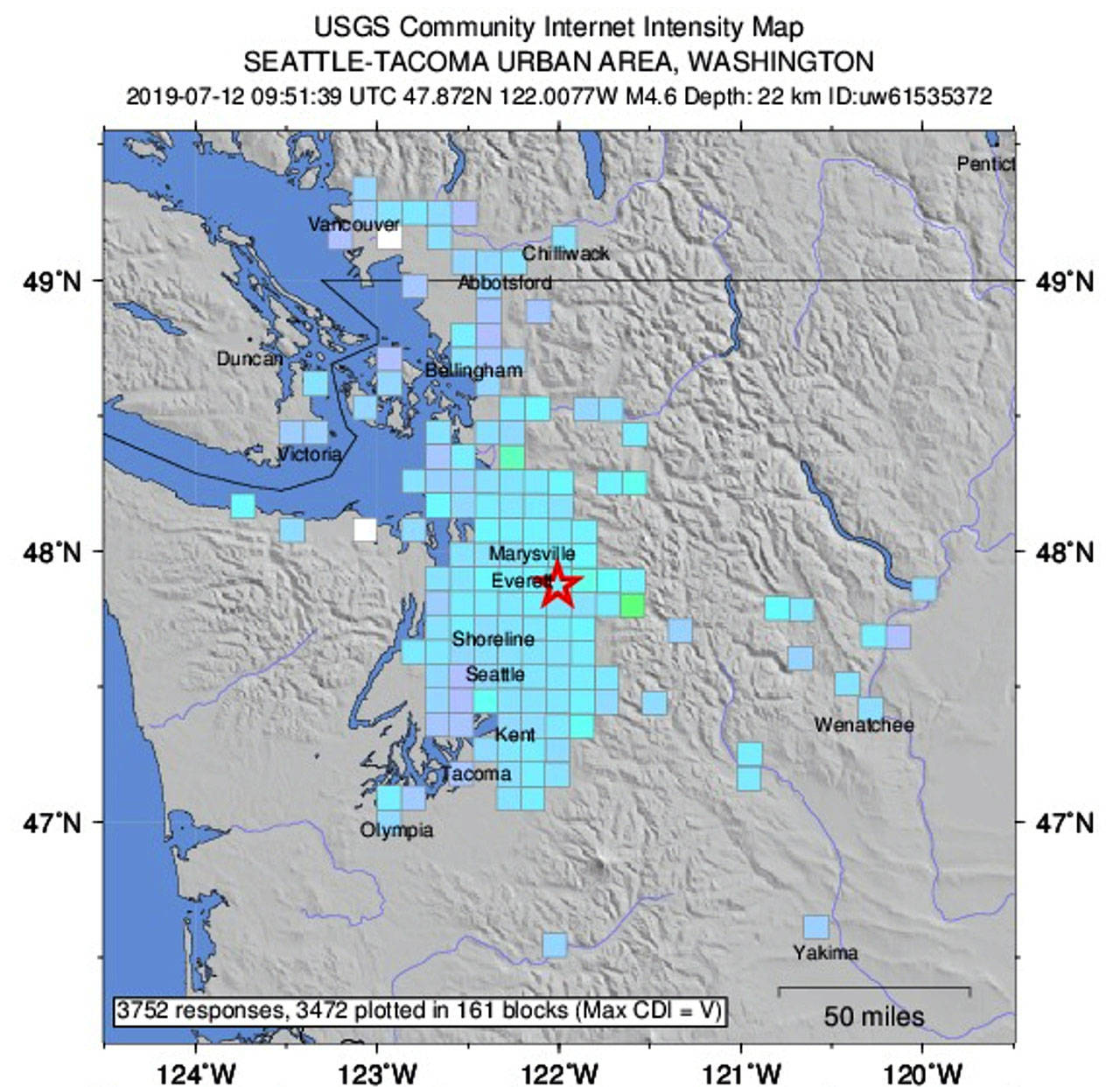MONROE — Thousands of Puget Sound-area residents were shaken awake early Friday as twin earthquakes hit the region, minutes apart and centered under Monroe, according to the U.S. Geological Survey.
The first quake, magnitude 4.6 and 13½ miles deep, hit at 2:51 a.m. A second one two minutes later was magnitude 3.5 and 18 miles deep. The first of at least five aftershocks followed at 2:56 a.m. Over the next couple of hours, they ranged from 1.7 to 0.9.
The Snohomish County Sheriff’s Office and other government agencies said there were no reports of damage, and the quakes did not pose a tsunami threat, according to a tweet by the U.S. National Tsunami Warning Center. However, the Snohomish County Public Utility District reported that some customers in the area lost power. Electricity was restored to most within a couple of hours.
The shaking awakened people as far away as Seattle. A USGS intensity map suggested the earthquakes could be felt as far south as Olympia and as far north as Vancouver, British Columbia.
Officials were soliciting reports from those who felt the shaking. By 7 a.m., more than 6,000 people had submitted reports to the U.S. Geological Survey to document the effects.
In an email, a Mukilteo resident described how it felt to him: “Awakened by low rumble. As I became awake, the house shook horizontally back and forth a couple of times, the quake being like a ripple on water, traveling through the ground. Eerie feeling — the shaking didn’t wake me, it was the sound. As the shaking stopped I could faintly hear the sound of the quake as the shock wave traveled on.”
The low rumble was also heard in Everett, where the shake rattled buildings side to side. The second tremor was softer and shorter.
In Seattle, the quake could be felt as a gentle rocking.
The first quake originated 13 miles under the intersection of Fryelands Boulevard SE and U.S. 2 on the east side of Monroe, according to a USGS map.
The epicenter of the second one was about a mile or so southwest of there, east of the city and focused 18 miles under the Old Snohomish-Monroe Road.
No initial reports of damage from this morning's shaking in @SnoCounty. A good reminder of the risk beneath our feet. These interactive maps and checklists can help you prepare. https://t.co/PrZeY6mVVs pic.twitter.com/nDp7sPPf6j
— Snohomish County DEM (@SnoCo_DEM) July 12, 2019
Smaller quakes like the ones Friday are not unusual in this area. And there have been bigger ones over the decades.
A 2012 Herald story reported that since 1900, six earthquakes of magnitude 5.0 or greater have been recorded as having caused damage in Snohomish and Island counties, or were centered within the counties’ borders.
Two significant faults run through Snohomish and Island counties. The South Whidbey Island Fault Zone consists of several intermittent faults that run from the Strait of Juan de Fuca southeast across Whidbey Island and south Snohomish County to Woodinville. The Devils Mountain Fault runs from the Strait of Juan de Fuca east near Deception Pass and across the Skagit-Snohomish county line southeast to Darrington.
Geologic evidence shows that large quakes have happened in the South Whidbey and Devils Mountain fault zones in the distant past. One happened in 1950 in the South Whidbey fault zone but data were inconclusive about the fault of origin, according to the University of Washington Seismology Lab.
Quakes on those faults carry a potential magnitude of 7.5, which could cause severe damage because of their proximity to the surface, according to a natural hazard report done for Snohomish County in 2010.
A possibly more serious threat is a quake in the Cascadia Subduction Zone 50 miles off the Pacific coast, which could inflict a quake of up to 9.5 in magnitude, causing catastrophic damage and capable of starting a tsunami.
Information from The Daily Herald’s archive is included in this story.
More online


